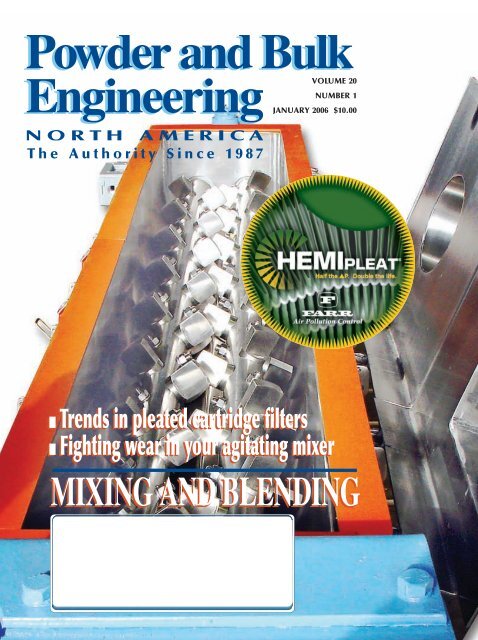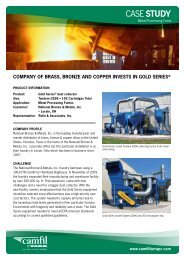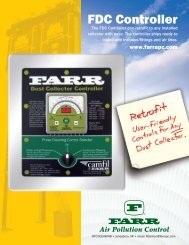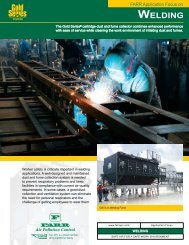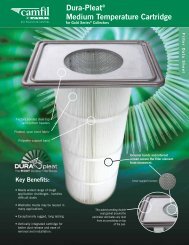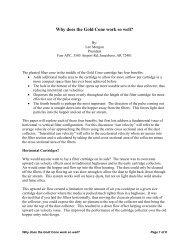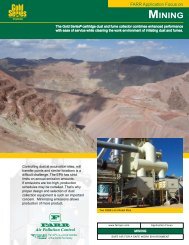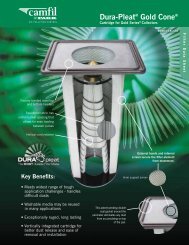Article - Trends in Pleated Cartridge Filters - Camfil APC
Article - Trends in Pleated Cartridge Filters - Camfil APC
Article - Trends in Pleated Cartridge Filters - Camfil APC
You also want an ePaper? Increase the reach of your titles
YUMPU automatically turns print PDFs into web optimized ePapers that Google loves.
k-Farr_46-51 1/23/06 11:13 AM Page 1<br />
Powder and Bulk<br />
Eng<strong>in</strong>eer<strong>in</strong>g<br />
NORTH AMERICA<br />
The Authority S<strong>in</strong>ce 1987<br />
VOLUME 20<br />
NUMBER 1<br />
JANUARY 2006 $10.00<br />
■ <strong>Trends</strong> <strong>in</strong> pleated cartridge filters<br />
■ Fight<strong>in</strong>g wear <strong>in</strong> your agitat<strong>in</strong>g mixer<br />
MIXING AND BLENDING
k-Farr_46-51 1/23/06 11:13 AM Page 2<br />
Repr<strong>in</strong>ted from Powder and Bulk Eng<strong>in</strong>eer<strong>in</strong>g, January 2006 www.powderbulk.com<br />
<strong>Trends</strong> <strong>in</strong> pleated cartridge filters<br />
Lee Morgan Farr Air Pollution Control<br />
Choos<strong>in</strong>g the right pleated cartridge filter can improve<br />
your cartridge collector’s dust capture efficiency,<br />
help it operate more reliably, and reduce its<br />
energy and ma<strong>in</strong>tenance requirements. To help you<br />
make an <strong>in</strong>formed choice, this article discusses<br />
some recent advances <strong>in</strong> pleated cartridge filter<br />
technology.<br />
Acartridge collector is the most popular dust collector<br />
for bulk solids handl<strong>in</strong>g operations today. This<br />
high-efficiency unit is more compact than a baghouse<br />
collector and operates at a lower pressure drop. The<br />
cartridge collector can be designed to reduce emissions<br />
well below OSHA limits, 1 often allow<strong>in</strong>g it to recirculate<br />
the air back to the plant for significant energy sav<strong>in</strong>gs.<br />
However, many of us mistakenly th<strong>in</strong>k of the collector’s<br />
replaceable pleated cartridge filters as generic, <strong>in</strong>terchangeable<br />
items. In fact, design and performance can<br />
vary markedly from filter to filter.<br />
Mak<strong>in</strong>g an <strong>in</strong>formed decision when select<strong>in</strong>g a cartridge<br />
filter can improve your collector’s dust capture efficiency<br />
and reliability while reduc<strong>in</strong>g its energy and ma<strong>in</strong>tenance<br />
requirements. This means you need to consider several<br />
<strong>in</strong>ter-related factors — <strong>in</strong>clud<strong>in</strong>g the filter’s mount<strong>in</strong>g position,<br />
media type, configuration, and pleat spac<strong>in</strong>g — and<br />
recent technology advances for each. Dur<strong>in</strong>g your selection<br />
process, it can be helpful to work with an <strong>in</strong>dependent dust<br />
collection consultant. This expert can help you sift through<br />
the many new filter technologies available and f<strong>in</strong>d the<br />
right comb<strong>in</strong>ation of filter features for your application.<br />
Mount<strong>in</strong>g position<br />
How a cartridge filter is mounted or <strong>in</strong>stalled <strong>in</strong> the collector<br />
has a major impact on the pleated media’s performance.<br />
In early cartridge collectors with vertically<br />
mounted filters and a clean-air plenum located at the collector<br />
top, dirty air would enter the collector’s hopper and<br />
flow upward <strong>in</strong>to the filter hous<strong>in</strong>g, as shown <strong>in</strong> Figure 1a.<br />
Dur<strong>in</strong>g the clean<strong>in</strong>g cycle, dust could be cleaned off the<br />
filters only if the upward-flow<strong>in</strong>g dirty air was flow<strong>in</strong>g<br />
slowly enough to allow the dislodged dust to fight its way<br />
back down through the dirty airstream. This arrangement<br />
worked well for heavy dusts, but not for lighter ones.<br />
The upward airflow through these cartridge collectors,<br />
where the media was packed much more tightly than <strong>in</strong> a<br />
baghouse collector, resulted <strong>in</strong> an upward can velocity (the<br />
average velocity of air approach<strong>in</strong>g the filters us<strong>in</strong>g the<br />
collector’s entire cross-sectional area) that created a limit<br />
on the amount of air that could enter a collector of a given<br />
size. For this reason, the next cartridge collector design <strong>in</strong>corporated<br />
filters mounted on their sides — that is, horizontally<br />
— so that the clean air plenum was now at one<br />
side of the collector, as shown <strong>in</strong> Figure 1b. The <strong>in</strong>com<strong>in</strong>g<br />
airflow entered through the collector top, creat<strong>in</strong>g a downflow<br />
effect to help dust dislodged dur<strong>in</strong>g the clean<strong>in</strong>g<br />
cycle overcome the upward can velocity found <strong>in</strong> the older<br />
vertically mounted cartridge collectors. This design<br />
change improved the cartridge collector’s performance<br />
over that of the older hopper-entry collector.<br />
Yet mount<strong>in</strong>g a filter on its side has some limitations. The<br />
biggest problem is that the dust doesn’t get cleaned off the<br />
filter’s upper side, caus<strong>in</strong>g the dust to bl<strong>in</strong>d at least one<br />
third of the entire filter, as shown <strong>in</strong> Figure 2. This dust accumulation<br />
<strong>in</strong>creases the air-to-media ratio (determ<strong>in</strong>ed<br />
by divid<strong>in</strong>g the process air volume by the filter’s media<br />
area; also called air-to-cloth ratio) and can lead to premature<br />
filter failure. One way to reduce this problem is to rotate<br />
each filter 180 degrees once a month. Another<br />
problem with horizontal mount<strong>in</strong>g is that, because all the<br />
<strong>in</strong>com<strong>in</strong>g dust enters at the collector’s top and lands on the<br />
filter tops, there’s no chance to preseparate heavy or abrasive<br />
particles from the dirty airstream. This can shorten the<br />
filter life.<br />
Today’s newest cartridge collectors have vertically<br />
mounted filters and a high, side-entry airflow <strong>in</strong>let that directs<br />
the air <strong>in</strong>to a cross-flow pattern across the collector at<br />
the same height as the filters, as shown <strong>in</strong> Figure 1c. The<br />
air first flows through a series of staggered baffles. These
k-Farr_46-51 1/23/06 11:13 AM Page 3<br />
baffles distribute the air throughout the hous<strong>in</strong>g and act as<br />
a classifier, separat<strong>in</strong>g the heavier particles so they drop<br />
straight <strong>in</strong>to the hopper without contact<strong>in</strong>g the filters. This<br />
cross-flow effect elim<strong>in</strong>ates upward can velocity, thus provid<strong>in</strong>g<br />
a downward airflow pattern without hav<strong>in</strong>g to turn<br />
the filters on their sides.<br />
Media types<br />
While many media types have been around for years, the<br />
range of available media for pleated cartridge filters is expand<strong>in</strong>g<br />
as new technologies enhance media filtration and<br />
clean<strong>in</strong>g capabilities.<br />
Available types and their applications. The most commonly<br />
used media <strong>in</strong> pleated cartridge filters is a nonwoven<br />
cellulose-synthetic blend. This media is an<br />
economical choice for dry dust collection applications at<br />
operat<strong>in</strong>g temperatures up to 180°F.<br />
A polyester-silicon blend media with a melt-blown synthetic<br />
applied to its surface is a good choice for achiev<strong>in</strong>g<br />
emissions as low as 1 mg/m 3 or less — far below the<br />
OSHA limit for nuisance dusts. This media can handle dry<br />
or moist applications with operat<strong>in</strong>g temperatures up to<br />
180°F while provid<strong>in</strong>g a smooth surface for better dust release,<br />
thus facilitat<strong>in</strong>g filter clean<strong>in</strong>g.<br />
Spunbonded polyester media is suited to applications with<br />
hot, moist airstreams <strong>in</strong> operat<strong>in</strong>g temperatures up to<br />
250°F. The media can also handle hygroscopic dusts and<br />
applications requir<strong>in</strong>g regular filter washdowns.<br />
Although compar<strong>in</strong>g the filters’ total media area is<br />
useful, it’s more mean<strong>in</strong>gful to compare their usable<br />
media area.<br />
Other specialized media have been developed for more<br />
demand<strong>in</strong>g applications, <strong>in</strong>clud<strong>in</strong>g heat-resistant media<br />
for very high temperature applications, flame-retardant<br />
f<strong>in</strong>ishes for applications with flammable dusts, carbon-impregnated<br />
f<strong>in</strong>ishes for dissipat<strong>in</strong>g static, and ultrahigh-efficiency<br />
media for remov<strong>in</strong>g toxic dusts.<br />
Media area and capture efficiency. Use caution when<br />
compar<strong>in</strong>g the media area (stated <strong>in</strong> square feet or meters)<br />
<strong>in</strong> different cartridge filters. Although compar<strong>in</strong>g the filters’<br />
total media area is useful, it’s more mean<strong>in</strong>gful to<br />
compare their usable media area. With horizontally<br />
mounted filters, a large proportion of their usable media<br />
area can be lost when dust collects on the filter tops, caus<strong>in</strong>g<br />
uneven dust load<strong>in</strong>g around each filter. With vertically<br />
mounted filters, pleat spac<strong>in</strong>g and other filter design factors<br />
(discussed later <strong>in</strong> this article) can have a dramatic impact<br />
on how much media area is usable.<br />
Clean<br />
air out<br />
<strong>Cartridge</strong><br />
filters<br />
Dirty<br />
air <strong>in</strong><br />
Dust out<br />
Dirty<br />
air <strong>in</strong><br />
<strong>Cartridge</strong><br />
filters<br />
Dust out<br />
Clean<br />
air out<br />
Dirty<br />
air <strong>in</strong><br />
<strong>Cartridge</strong><br />
filters<br />
Dust out<br />
Figure 1<br />
<strong>Cartridge</strong> collector designs<br />
a. Airflow entry at hopper, vertically mounted filters<br />
b. Airflow entry at top, horizontally mounted filters<br />
c. Airflow entry at side, vertically mounted filters<br />
Clean<br />
air out
k-Farr_46-51 1/23/06 11:13 AM Page 4<br />
Also don’t rely on manufacturers’ claims about a media’s<br />
capture efficiency stated as a percentage, such as “99.5<br />
percent efficiency.” OSHA <strong>in</strong>door air quality limits are<br />
measured not <strong>in</strong> percentages but <strong>in</strong> milligrams per cubic<br />
meter, so you must make sure that the amount of dust <strong>in</strong><br />
your collector’s exhaust is less than the established OSHA<br />
limits <strong>in</strong> these units of measure. A reputable collector or<br />
filter manufacturer should guarantee that emissions from<br />
your collector will be below OSHA’s allowable threshold<br />
for your dust.<br />
Filter configuration<br />
In a standard cartridge filter, the pleated media is formed<br />
<strong>in</strong>to a long cyl<strong>in</strong>der and sealed at the top and bottom with<br />
end caps. Dust collects on the filter’s outside surface and,<br />
dur<strong>in</strong>g clean<strong>in</strong>g, is dislodged by a burst of compressed air<br />
blasted <strong>in</strong>to the filter’s <strong>in</strong>terior. By knock<strong>in</strong>g the dust off<br />
the filter’s exterior, this reverse pulse of air cleans the filter<br />
so that it can filter more air.<br />
One problem with a standard cartridge filter, whether<br />
mounted horizontally or vertically, is that a significant portion<br />
of the clean<strong>in</strong>g energy is wasted <strong>in</strong> puls<strong>in</strong>g the cartridge’s<br />
bottom end cap, as shown <strong>in</strong> Figure 3a. <strong>Cartridge</strong><br />
filters have recently been designed with an <strong>in</strong>ternal structure,<br />
such as a cone or barrel, made of pleated media (usually<br />
the same media as that <strong>in</strong> the outer layer) and with a<br />
bottom hole rather than an end cap. This allows the filters<br />
to use the puls<strong>in</strong>g energy that otherwise would have been<br />
wasted puls<strong>in</strong>g the bottom end cap and distribute the<br />
clean<strong>in</strong>g air more evenly through the filter, as shown <strong>in</strong><br />
Figure 3b. The result is a lower pressure drop, requir<strong>in</strong>g<br />
fewer clean<strong>in</strong>g pulses. The filters also prevent re-entra<strong>in</strong><strong>in</strong>g<br />
the dislodged dust. As each clean<strong>in</strong>g air pulse comes<br />
out of the <strong>in</strong>ternal cone or barrel, it flows straight down<br />
Figure 2<br />
Dust accumulation on horizontally<br />
mounted cartridge filters<br />
<strong>in</strong>to the collector’s hopper. This forces lightweight dislodged<br />
dust particles <strong>in</strong>to the hopper and out of the <strong>in</strong>com<strong>in</strong>g<br />
dirty airstream <strong>in</strong>stead of push<strong>in</strong>g the dust toward the<br />
other filters dur<strong>in</strong>g the pulse.<br />
Pleat spac<strong>in</strong>g<br />
You also need to consider the spac<strong>in</strong>g between the cartridge<br />
filter’s pleats when select<strong>in</strong>g a filter. For years, one<br />
problem with pleated cartridge filters has been tight pleat<br />
spac<strong>in</strong>g that prevents the dust build<strong>in</strong>g up <strong>in</strong> the pleats<br />
from be<strong>in</strong>g easily removed with reverse-pulse clean<strong>in</strong>g.<br />
Most filters are made with pleat<strong>in</strong>g mach<strong>in</strong>es that crease<br />
Figure 3<br />
Air distribution dur<strong>in</strong>g pulse clean<strong>in</strong>g<br />
a. In standard cartridge filter<br />
b. In cartridge filter with <strong>in</strong>ternal structure<br />
Clean<strong>in</strong>g<br />
air pulse<br />
Bottom<br />
end cap<br />
Hole
k-Farr_46-51 1/23/06 11:13 AM Page 5<br />
the media <strong>in</strong>to an S shape, p<strong>in</strong>ch<strong>in</strong>g off the pleat’s bottom<br />
half (toward the filter’s <strong>in</strong>terior), as shown <strong>in</strong> Figure 4.<br />
This pleat<strong>in</strong>g method tightly compresses the pleats, leav<strong>in</strong>g<br />
much of the media area unavailable for filter<strong>in</strong>g and allow<strong>in</strong>g<br />
dust to rema<strong>in</strong> trapped <strong>in</strong> the filter even after<br />
clean<strong>in</strong>g.<br />
Filter manufacturers have developed cartridge filters with<br />
open-pleat designs to overcome these problems. One type<br />
is a spunbonded polyester open-pleat filter with pleats that<br />
are dimpled along their vertical length. This dimple prevents<br />
adjacent pleats from touch<strong>in</strong>g, mak<strong>in</strong>g more usable<br />
media area available and facilitat<strong>in</strong>g dust release so that<br />
filter clean<strong>in</strong>g requires fewer pulses and, thus, less energy.<br />
In another type of open-pleat filter, hot-melt separator<br />
beads — that is, <strong>in</strong>termittent beads or dots of hot-melt glue<br />
— between pleats on the <strong>in</strong>terior media side form a rigid<br />
structure that ma<strong>in</strong>ta<strong>in</strong>s uniform pleat spac<strong>in</strong>g, as shown<br />
<strong>in</strong> Figures 5a and b. 2 Based on a pleat<strong>in</strong>g method developed<br />
for manufactur<strong>in</strong>g high-efficiency particulate air<br />
(HEPA) filter media for clean rooms, the hot-melt separator<br />
beads open up the entire pleat length, enabl<strong>in</strong>g the full<br />
pleat depth to be used for filter<strong>in</strong>g and allow<strong>in</strong>g higher airflow<br />
per square foot of media than older pleat<strong>in</strong>g methods.<br />
By compar<strong>in</strong>g the pleat spac<strong>in</strong>g shown <strong>in</strong> Figures 4 and 5,<br />
you can see that the filter with hot-melt bead pleat spac<strong>in</strong>g<br />
(Figure 5) has more usable media area than the filter with<br />
tighter pleat spac<strong>in</strong>g (Figure 4). The greater amount of usable<br />
media area allows the filter to hold more dust between<br />
clean<strong>in</strong>g pulses, produces a significantly lower pressure<br />
drop, and improves dust release dur<strong>in</strong>g clean<strong>in</strong>g.<br />
In addition to consider<strong>in</strong>g pleat spac<strong>in</strong>g, be cautious about<br />
select<strong>in</strong>g a cartridge filter encircled with an exterior cage.<br />
The cage is meant to help the pleats ma<strong>in</strong>ta<strong>in</strong> their shape<br />
dur<strong>in</strong>g reverse-pulse clean<strong>in</strong>g, but the cage covers some of<br />
Figure 4<br />
Tightly compressed pleats (top view)<br />
the pleats’ open area and can trap dust, prevent<strong>in</strong>g it from<br />
leav<strong>in</strong>g the filter dur<strong>in</strong>g clean<strong>in</strong>g and potentially shorten<strong>in</strong>g<br />
the filter’s life. To avoid these problems, select a filter<br />
that uses cords, bands, or similar devices around the filter.<br />
These devices cover much less of the filter’s open area and<br />
don’t trap dust. PBE<br />
References<br />
1. F<strong>in</strong>d <strong>in</strong>formation on permissible exposure limits for your dust on<br />
OSHA’s Web site at www.osha.gov (search for “permissible exposure<br />
limits”), or contact OSHA at 200 Constitution Avenue Northwest,<br />
Wash<strong>in</strong>gton, D.C. 20210; 800-321-6742.<br />
2. HemiPleat cartridge filter, Farr Air Pollution Control, Jonesboro,<br />
Ark.<br />
Lee Morgan is general manager of Farr Air Pollution Control,<br />
3505 South Airport Road, Jonesboro, AR 72401; 800-<br />
479-6801, fax 870-910-7137 (morganl@farrapc.com,<br />
www.farrapc.com). He holds a BS <strong>in</strong> mechanical eng<strong>in</strong>eer<strong>in</strong>g<br />
from South Dakota State University <strong>in</strong> Brook<strong>in</strong>gs.<br />
Figure 5<br />
Open pleats made with hot-melt separator beads<br />
a. Exterior view<br />
b. Interior view
k-Farr_46-51 1/23/06 11:14 AM Page 6<br />
HemiPleat vs. Standard Filter<br />
Farr <strong>APC</strong> is a proud member of the <strong>Camfil</strong> Farr family.<br />
Additional <strong>APC</strong> offices and factories <strong>in</strong> Laval, Canada (450-629-3030), and UK (44-121-707-8211)<br />
For dust collector filtration,<br />
it’s an<br />
> Fits Any Dust Collector — available as replacement upgrade cartridges.<br />
> 100% Media Use — captures more air pollutants for a safer, cleaner work environment.<br />
> Saves Money & Time — less ma<strong>in</strong>tenance and longer filter life.<br />
Patent Pend<strong>in</strong>g Technology<br />
It’s a fact.<br />
HemiPleat collects more dust, pulses better, lasts longer & saves money.<br />
> High Filter Efficiency — Polytech HE filter media delivers high efficiencies–99.999% on 0.5 μ particles.<br />
> Enhanced Pulse-Jet Clean<strong>in</strong>g — dust is ejected from deep with<strong>in</strong> the pleats.<br />
> Breathable Media Pleats — reduces the “dirty work” of replac<strong>in</strong>g filters.<br />
> Lower Pressure Drop (▲P) — open pleat spac<strong>in</strong>g improves clean<strong>in</strong>g efficiency.<br />
> HemiPleat Technology — now standard on new Farr Gold Series Dust Collectors.<br />
> Available Polytech HE Media — has an <strong>in</strong>dustry high MERV 15 efficiency rat<strong>in</strong>g.<br />
“The HemiPleat solved my cartridge life problems.<br />
The dust blows right out of the pleats whereas<br />
it wouldn’t with standard pleats.”<br />
—Grant Bowry, Environmental Air Systems, Inc.<br />
Old Technology<br />
Call today! 800-479-6801 or 870-933-8048<br />
www.farrapc.com<br />
Jonesboro, AR • email: filterman@farrapc.com


